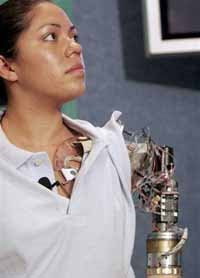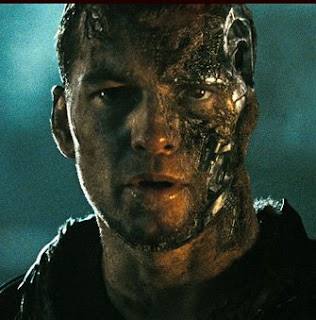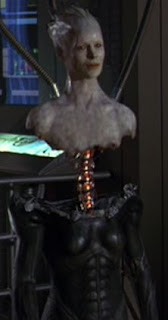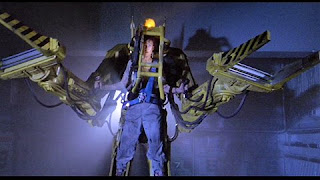BIOMECHATRONICS

In the field of Biomechatronics(1) the integration of man and machine can be achieved through internal or external body/machine interfaces. Exploration of internal interfaces between the nervous, muscular, and other body systems are represented in movies like Terminator Salvation and Star Trek: First Contact, where living flesh encases machinery(2). We'll look at some aspects of internal interfaces in future posts.
You'll recall from SMORGASBORG #1 that my gauge for a cyborg is "some kind of sensory and/or motor interface between the man (or biological tissues) and his machine parts. This involves the exchange of data and of energy. This relationship between two independent systems (man and machine in the case of the movies we will look at) is a dynamic one, where each influence the other."(3)

Claudia Mitchell with a new prosthetic arm.
This one's real, folks!
This criterion for cyborgism means that a person wearing a truly biomechatronic exoskeleton, whether invasive or not, could fit the model of a cyborg. One can also be provided sensory and motor interfaces that are non-invasive. A person can be encased (all the way or partially) in an exoskeletal structure that provides feedback to the wearer. Cybernetic devices could be directed through physical manipulation, voice commands, or in some cases, thought commands. Electrodes and other types of sensors can read nervous impulses and brain waves via contact with the skin. Sensory information can be provided to the user of the device through skin contact, aurally, and visually.

Lobster attacked by a baby
(Thank you, Bill Rahner, for the photo!)
GETTING HUNGRY...
I have read (and heard) the exoskeletal construction of a cyborg described as a "lobster." It's an appropriate nickname if you think about it. This type of cyborg has a hard outer shell and a tender, juicy middle. Makes you want to throw Iron Man, live, into a big pot of boiling water, cook him up, then crack him out of his shell and eat him with melted butter. The more I think about dipping Robert Downey Jr. into melted butter, the more I like the "lobster" thing.

Iron Man, Matrix Revolutions, and Aliens fulfill the model of the exoskeleton with greater and lesser degrees of technological finesse. Stark is encased entirely in his "power suit" (power suit?!?!), has a visual, and probably a tactile, interface, and talks to Jarvis (a computer of artificial intelligence) through his suit, to give commands and request information. In Matrix, the Armored Personnel Unit is an exoskeletal weapon. There is direct communication with the external environment. It's a big walking gun with a person in it. Captain Mifune goes down in one while battling the machines (Sentinels? I forget what they're called). It's a good fight scene.

Nathanael Lees as Captain Mifune
From Cyberpunk Review
In Aliens, Ripley(4) makes herself the crudest cyborg of all. Much of her body is exposed. Her exosuit cargo loader is, well, a cargo loader, it has buttons and levers. Ripley uses it as a weapon. It's not clear in the film if she is provided with any feedback from the suit, or if information travels only from her to it. She does walk in the suit, which I think would require some type of feedback mechanism in order to maintain balance, but I'm not a biomechanic.
If we take this lobster-as-cyborg imagery too far, anyone in a car might be encased in an exoskeleton, and therefore a cyborg. I'm not willing to go there. Another feature that may disqualify these characters from being true cyborgs is that they can remove themselves from their casings at any time. On the other hand, I haven't read anything that decrees Once a Cyborg, Always a Cyborg.
Next time we look at exoskeletons, prosthetics, and some real life applications for a power suit.
1. Biomechatronics is an interdisciplinary field that combines robotics, neuroscience, "interface and sensory technology, and dynamic systems and control theory," whatever they are. The objective of biomechatronics is to create implements that interact with the body in order to restore it to mechanical function, or enhance its function. Biomechatronics - Assisting the Impaired Motor System, by P.H. Vletnik, et. al. is a fascinating read on this topic. The article is from the Archives of Physiology and Biochemistry 2001, Vol. 109, No 1, pp. 1-9. If you don't have access to the right database (hmmm, grad school has its advantages), you can purchase it through Pub Med, if you're inclined.
2. Of course, each movie has its own set of rules. In Star Trek it is revealed the Borg cannot survive without their fleshy parts, no matter how seemingly small a percentage of the Borg body is flesh. This is a major plot point regarding how the crew of the Enterprise overcome a Borg invasion. In contrast are the cybernetic organisms in the Terminator series, who lose their flesh and keep on going.
3. Cripes! Now I'm quoting myself!
4. Another actor to consider dipping in butter.











